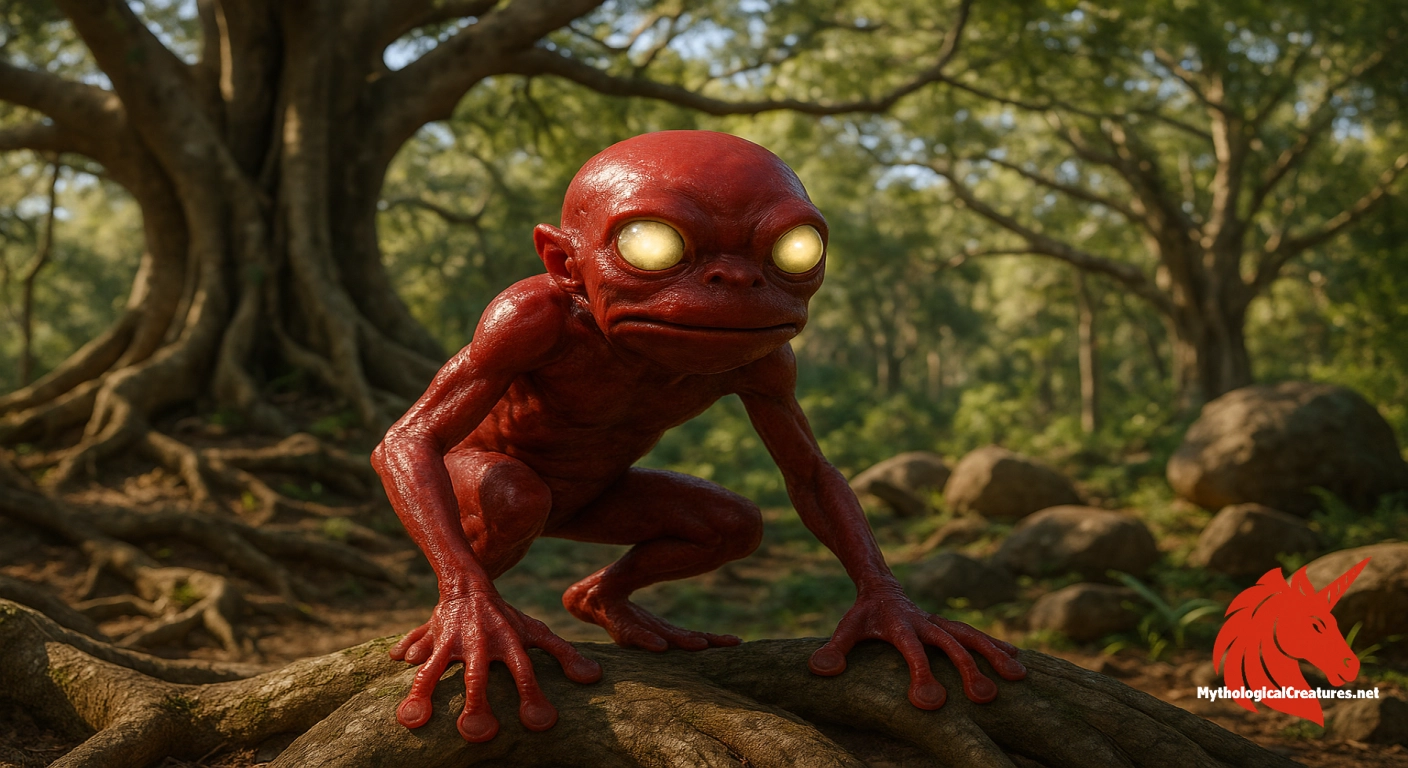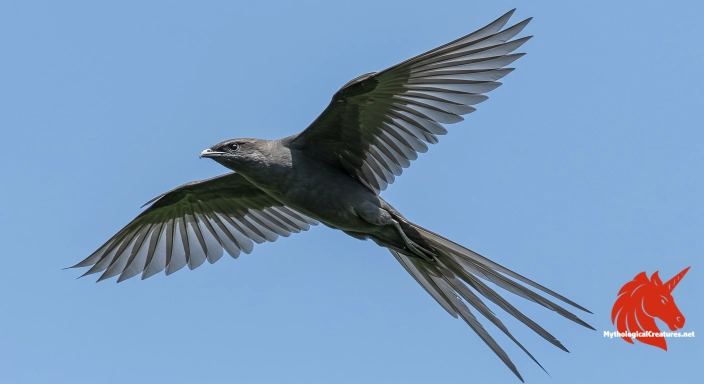Yara-ma-yha-who: The Yara-ma-yha-who is a small, red, frog-like humanoid vampiric monster from Southeastern Australian Aboriginal mythology.

Yara-ma-yha-who
Yara-ma-yha-who - Serves as a moral warning in Aboriginal folklore, embodying transformation and the dangers of misbehaviour.
Origins & First Encounters
Emerging from the rich tapestry of Southeastern Australian Aboriginal heritage, the Yara-ma-yha-who presents a peculiar blend of mystery and caution. The creature has long lived in the collective imagination of indigenous communities, its roots intertwined with the natural landscape of the region. Its earliest attestations appear in oral recitations that were later recorded and popularised by figures like David Unaipon. The myth envisions a being that lurks in the fringes of the natural world, infusing familiar settings with an air of inexplicable danger. Every retelling casts it as a transformative force that disrupts the normal order of human life. The narrative serves to caution against carelessness and to remind listeners that nature conceals secrets that may alter destinies. The Yara-ma-yha-who stands as both a mysterious adversary and a symbol of nature’s unexpected retribution. Its story, passed down through generations, continues to captivate and instruct those who hear it. This enduring legend remains a testament to the power of myth in framing cultural values and human vulnerability.
Source Texts & Tale Variants
The accounts of the Yara-ma-yha-who have been preserved through the vibrant oral traditions of Aboriginal communities and later documented by influential voices. Early written records, most notably those collected by David Unaipon, provide one of the first modern attestations of its story. The narrative has been handed down over centuries, each generation adding layers of nuance and local detail. In many retellings, the creature’s method of ambushing unsuspecting travellers under fig trees is maintained with striking consistency. Variations often emerge in the specifics of its behaviour and the transformative effect it has on its victims. Some storytellers accentuate its role as a cautionary figure, while others delve into its more mystical attributes. The lore is rich with diverse details that mirror the values and environmental observations of different communities. This multiplicity of versions has allowed the myth to evolve, ensuring that the creature remains a dynamic element in cultural storytelling. The enduring legacy of these narratives is a reflection of both historical tradition and the creative reinterpretation of myth over time.
Form & Powers
Visually striking, the Yara-ma-yha-who is depicted as a diminutive yet unforgettable being marked by a vivid red hue that recalls the flush of blood. Its compact, frog-like stature is accentuated by an unusually large head that gives it an otherworldly presence. A broad, toothless mouth adds a paradoxical element of benignity mixed with latent menace. Small, sucker-like appendages at the ends of its hands and feet not only define its distinctive appearance but also serve as the tools of its unusual predation. Each anatomical detail, from its glossy skin to the disproportionate features, contributes to a figure that is as eerie as it is memorable. The creature’s proportions appear to vary slightly in different tellings, with some accounts rendering it more agile and diminutive, and others suggesting a more imposing form. Its pronounced red colouring imbues the myth with a sense of vitality that borders on the supernatural. The fusion of amphibian characteristics with humanoid contours creates an uncanny visual that challenges conventional boundaries between man and beast. Every aspect of its physical presence has been meticulously crafted in the myth to evoke both awe and trepidation.
Regional Faces
Across the diverse landscapes of Southeastern Australia, the portrayal of the Yara-ma-yha-who adapts to the unique cultural imprints of each community. In some areas, this creature is portrayed with a touch of whimsy, serving as both a playful warning and a mysterious inhabitant of sacred fig trees. Local narratives often incorporate additional layers of mysticism, imbuing the being with traits that resonate with the spirit of the land. Certain communities emphasise its diurnal activity, a distinctive feature that sets it apart from nocturnal predators commonly found in other myths. Variations include subtle shifts in its physical description, such as adjustments in the intensity of its red complexion or the prominence of its suction appendages. In regions influenced by historical Malay migration, components of its portrayal have merged with traits reminiscent of exotic primate forms. These local adaptations highlight the fluidity of myth, where environmental context and cultural exchange continually reshape traditional narratives. Each retelling reflects the values, fears, and natural observations of the people, ensuring that the creature remains a living part of local heritage. Through these varied regional expressions, the Yara-ma-yha-who is a dynamic symbol whose characteristics evolve in step with the community’s collective memory.
Cultural Parallels
The Yara-ma-yha-who occupies a unique niche in mythological lore that invites comparison with vampiric figures from diverse cultural backgrounds. Its distinctly diurnal activity contrasts sharply with the nocturnal habits of European vampires, offering an alternative perspective on the nature of blood-sucking entities. This creature also shares thematic bonds with global trickster figures, whose interventions often lead to unexpected transformations in their victims. Its method of draining blood and inducing physical change echoes myths where supernatural encounters result in altered human natures. While many cultures portray vampires as elegantly sinister or overtly malevolent, this being combines elements of mischief with a subtle sense of natural order. The creature’s amphibian features further distinguish it from the typical humanoid form seen in other legends. Similar cross-cultural motifs of transformation and caution are woven into the fabric of myths worldwide, highlighting universal fears and curiosities. The interplay between its benign appearance and dangerous action provides a rich field for comparative analysis with other folkloric monsters. In essence, the Yara-ma-yha-who serves as a fascinating example of how diverse traditions repurpose common themes to explore the boundaries between humanity and the supernatural.
Legacy & Modern Evolution
Over time, the myth of the Yara-ma-yha-who has transitioned from an ominous tale shared to admonish wayward children to a subject of renewed fascination in modern cultural discourse. Its original role as a cautionary figure now finds echoes in contemporary art, literature, and digital storytelling, where the creature’s bizarre charm captivates new audiences. Contemporary depictions often play on the dual nature of its character, mixing elements of dark humour with an ever-present hint of menace. This evolving narrative demonstrates how the creature’s legacy has been reshaped to reflect changing societal attitudes toward myth and tradition. Modern reinterpretations focus on its transformative impact, symbolising the unpredictable power of nature to upend human expectations. Exhibitions and multimedia projects continue to explore the significance of this indigenous legend, showcasing its influence beyond the borders of Australia. The Yara-ma-yha-who is now part of a broader conversation about the role of folklore in preserving cultural history. As its story is retold in new and innovative ways, the creature retains an aura of mystery that keeps the ancient myth alive. The ongoing evolution of its portrayal underscores the adaptive nature of folklore and its power to inspire wonder in a contemporary context.
Interesting Fact
An intriguing aspect of the Yara-ma-yha-who is its ability to transform its victims through a process of blood drainage and regurgitation, a unique twist on traditional vampiric lore.
Quick Creature Info
Origin:
Features:
Our Mythic Legendary Rating:

Habitat:
Supernatural Powers:
Physical Attributes:
Abilities:
Behavior:
Lore:
Related Creatures, Tales or Lore
- EEuropean Vampire
- CChupacabra
- AAsanbosam
References
Discover Another Mythical Legend You May Not Have Heard Of?
Uncover the mysteries of ancient folklore and expand your knowledge of legendary beings from cultures around the world.
Dare to Meet the Martlet....
Curated by the Mythological Creatures Team (rev. May 2025)
